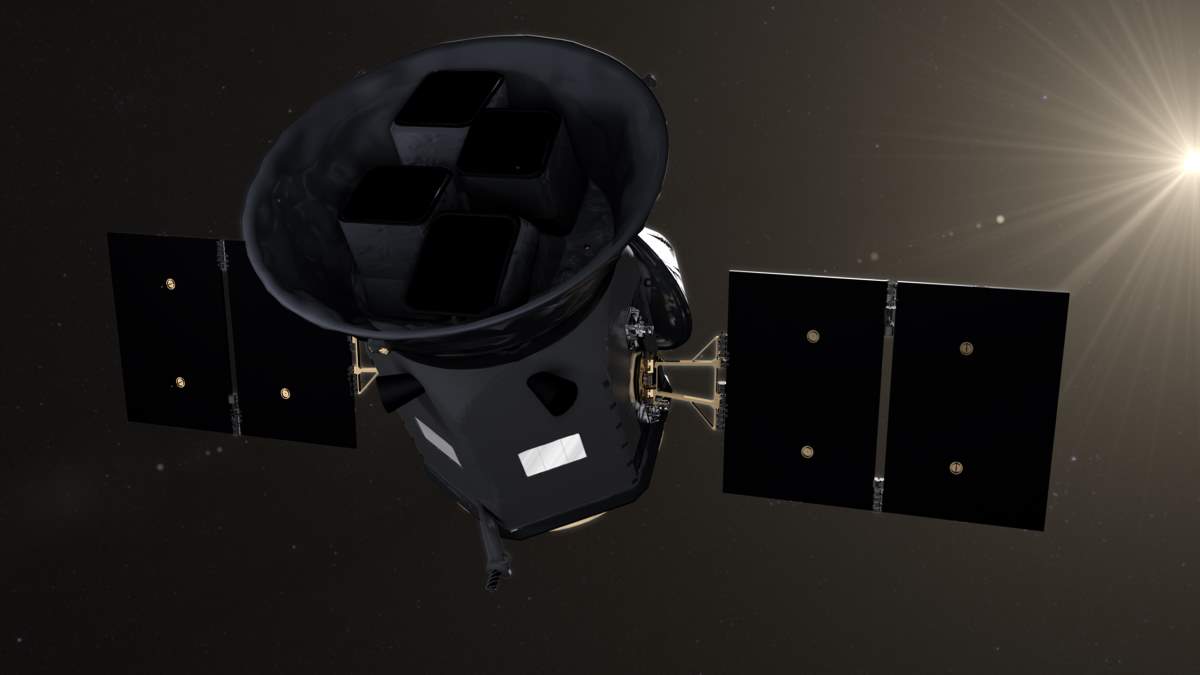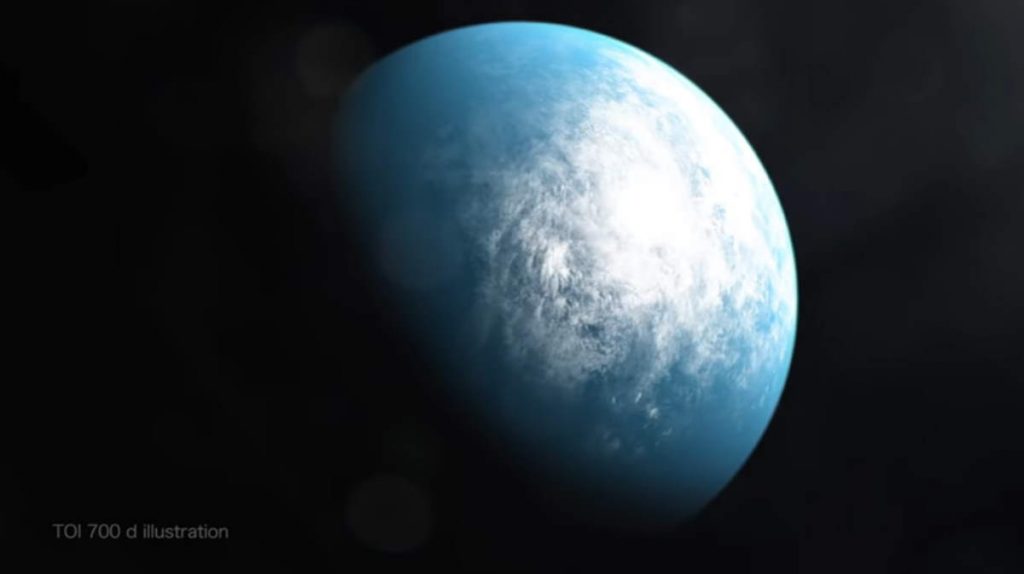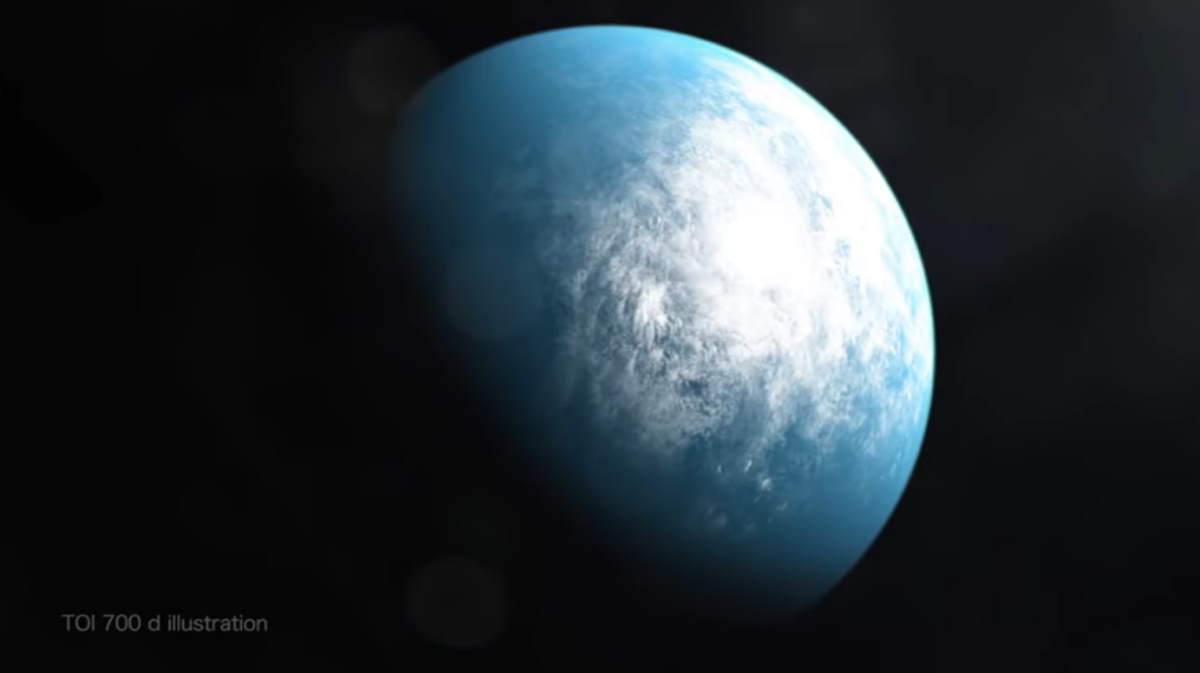Exciting news! NASA’s planet-hunter TESS Space Telescope (Transiting Exoplanet Survey Satellite) has discovered its first Earth-sized exoplanet in its star’s habitable zone. The discovery was announced by NASA on January 7, 2020. The planet is named “TOI 700 d”.
Using NASA’s Spitzer Space Telescope, astronomers confirmed the discovery and have modeled the planet’s potential environments to help inform future observations.
The planet is the outermost planet that orbiting a red*dwarf (an M-dwarf, M-type main sequence stars) star called “TOI 700”, about 100 light-years from the Sun. These stars have a mere fraction of the Sun’s mass and luminosity.
TOI 700 is 40% the mass, 40% the radius and 50% of the temperature of the Sun.
The habitable zone, also known as the “Goldilocks Zone” is the area around a star where it is not too hot and not too cold for liquid water to exist on the surface of surrounding planets.
The exoplanet TOI 700 d has an estimated mass of around 1.72 M⊕ (Earth’s mass) and a radius of 1.19 R⊕ (Earth’s radius).
Transiting Exoplanet Survey Satellite (TESS)
Transiting Exoplanet Survey Satellite (TESS) is a space telescope that launched on April 18, 2018, atop a SpaceX Falcon 9 rocket. Like the previous (now retired) Kepler Space Telescope, which observed 530,506 stars and detected 2,662 exoplanets, the TESS is using the transit method. But it covers an area 400 times larger than that covered by the Kepler mission.
If a planet crosses (transits) in front of its parent star’s disk, then the observed visual brightness of the star drops by a very small amount, depending on the relative sizes of the star and the planet. This drop can be measured by precise instruments on the space telescopes.
The drop in the star’s brightness must be absolutely periodic if it is caused by a planet. In addition, all transits produced by the same planet must be of the same change in brightness and last the same amount of time, thus providing a highly repeatable signal and robust detection method.
Once detected, the planet’s orbital size can be calculated from the period (how long it takes the planet to orbit once around the star) and the mass of the star using Kepler’s Third Law of planetary motion.
The size of the planet is found from the depth of the transit (how much the brightness of the star drops) and the size of the star. From the orbital size and the temperature of the star, the planet’s characteristic temperature can be calculated. From this, the question of whether or not the planet is habitable (not necessarily inhabited) can be answered.

Here is the press release about the discovery by the NASA:
NASA Planet-Hunter TESS Space Telescope Finds its 1st Earth-size Habitable-zone World

NASA’s Transiting Exoplanet Survey Satellite (TESS) has discovered its first Earth-size planet in its star’s habitable zone, the range of distances where conditions may be just right to allow the presence of liquid water on the surface. Scientists confirmed the find, called TOI 700 d, using NASA’s Spitzer Space Telescope and have modeled the planet’s potential environments to help inform future observations.
TOI 700 is a small, cool M dwarf star located just over 100 light-years away in the southern constellation Dorado. It’s roughly 40 of the Sun’s mass and size and about half of its surface temperature. The star appears in 11 of the 13 sectors TESS observed during the mission’s first year, and scientists caught multiple transits by its three planets.
The innermost planet, called TOI 700 b, is almost exactly Earth-size, is probably rocky, and completes an orbit every 10 days. The middle planet, TOI 700 c, is 2.6 times larger than Earth — between the sizes of Earth and Neptune — orbits every 16 days and is likely a gas-dominated world. TOI 700 d, the outermost known planet in the system and the only one in the habitable zone. It measures 20 percent larger than Earth, orbits every 37 days, and receives from its star 86% of the energy that the Sun provides to Earth. All of the planets are thought to be tidally locked to their star, which means they rotate once per orbit so that one side is constantly bathed in daylight.
The Spitzer data increased scientists’ confidence that TOI 700 d is a real planet and sharpened their measurements of its orbital period by 56% and its size by 38%. It also ruled out other possible astrophysical causes of the transit signal, such as the presence of a smaller, dimmer companion star in the system.
While the exact conditions on TOI 700 d are unknown, scientists used current information, like the planet’s size and the type of star it orbits, and modeled 20 potential environments for TOI 700 d to gauge if any version would result in surface temperatures and pressures suitable for habitability.
One simulation included an ocean-covered TOI 700 d with a dense, carbon-dioxide-dominated atmosphere similar to what scientists suspect surrounded Mars when it was young. The model atmosphere contains a deep layer of clouds on the star-facing side. Another model depicts TOI 700 d as a cloudless, all-land version of modern Earth, where winds flow away from the night side of the planet and converge on the point directly facing the star.
TESS also discovers its first exoplanet orbiting 2 stars
On January 6, NASA also announced that the TESS Space Telescope has discovered its first exoplanet orbiting two stars.
Researchers working with data from NASA’s Transiting Exoplanet Survey Satellite (TESS) have also discovered the mission’s first circumbinary planet, a world orbiting two stars. The planet, called TOI 1338b, is around 6.9 times larger than Earth, or between the sizes of Neptune and Saturn. It lies in a system 1,300 light-years away in the constellation Pictor.
The stars in the system make an eclipsing binary, which occurs when the stellar companions circle each other in our plane of view. One is about 10% more massive than our Sun, while the other is cooler, dimmer and only one-third the Sun’s mass.
TOI 1338b’s transits are irregular, between every 93 and 95 days, and vary in depth and duration thanks to the orbital motion of its stars. TESS only sees the transits crossing the larger star – the transits of the smaller star are too faint to detect. Although the planet transits irregularly, its orbit is stable for at least the next 10 million years. The orbit’s angle to us, however, changes enough that the planet transit will cease after November 2023 and resume eight years later.
Sources
- Transiting Exoplanet Survey Satellite (TESS) on Wikipedia
- Latest TESS Stories on NASA.gov
- “M Dwarfs Could Be the Best–or Worst–Extraterrestrial Homes” on the Scientific American website
- “5 Ways to Find a Planet” on NASA.gov
- Methods of detecting exoplanets on Wikipedia
- Kepler Mission overview on NASA.gov
- “NASA’s TESS Mission Uncovers Its 1st World With Two Stars” on NASA.gov
- Space Shuttle Endeavour’s Touchdown Meets Columbia’s Salute [An amazing photo from the past] - February 29, 2024
- Moon Landings: All-Time List [1966-2024] - February 23, 2024
- From Orbit to Ordinary: 10 Earthly Applications of Space Technology - January 23, 2024

